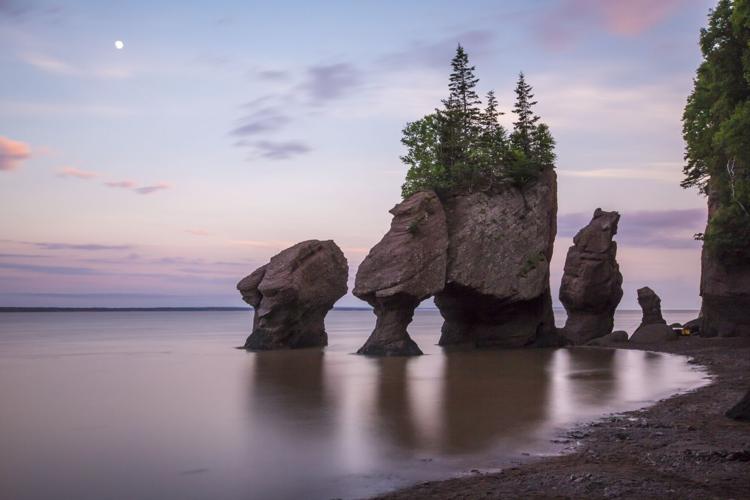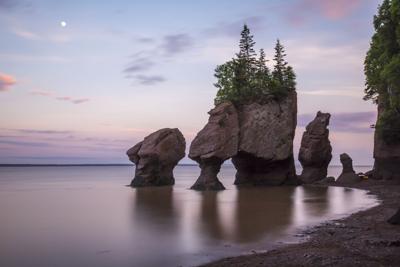Few places in Canada showcase nature’s raw power like New Brunswick’s Fundy coast, where the world’s highest tides shape a landscape of soaring cliffs and billion-year-old rock formations.
You don‚Äôt need to be an expert to appreciate the natural phenomena, but a tidal primer helps. The funnel-shaped Bay of Fundy has two high and two low tides every 24 hours. Each cycle moves nearly 100 billion tonnes of water ‚ÄĒ more than all the world‚Äôs rivers combined. (For perspective, the difference between high and low tide can reach 16 metres, the height of a four-storey building.)
Travellers wanting to fully experience this rugged coastline can take a road trip along the 460-kilometre , arguably one of Canada’s most scenic routes, particularly from spring through fall when the Fundy Trail Provincial Park is open. While it doesn’t matter which end you begin from, Moncton is a good place to start learning how the mighty Fundy tides affect the region.

The 460-kilometre Fundy Coastal Drive is arguably one of Canada’s most scenic routes.
Nick Hawkins/New Brunswick TourismTwice daily, the incoming tide rushes into the Petitcodiac River, which flows through the city. A low rumble can be heard at Bore Park in downtown Moncton as the leading edge of the tide meets the Petitcodiac head on, temporarily reversing the river‚Äôs flow and creating a bore ‚ÄĒ a wave about 0.5 to one metre¬†in height ‚ÄĒ travelling upstream. Smaller waves ripple behind.
At Hopewell Rocks Provincial Park, about a half-hour drive away, the Fundy tides again display their strength. When the park is open (from mid-May to mid-October), you can walk the ocean floor at low tide and look up to towering sea stacks, rock formations whose bases have been sculpted by the water‚Äôs relentless ebb and flow. The sea stacks, nicknamed ‚Äúflowerpots,‚ÄĚ are narrow at the bottom but sprout trees and other vegetation at their wider tops.
At high tide, you can view the coast from higher ground to see how the water reshapes the landscape. For a closer look at the natural arches and tunnels created by erosion, you can kayak through the sea stacks with a local tour operator like .

For a closer look at the natural arches at Hopewell Rocks, travellers can go kayaking with a local tour operator.
New Brunswick TourismFurther down the coast, the cliffs of Cape Enrage offer another vantage point to check out the world’s highest tides. The windswept headland’s name is a nod to the currents that have challenged sailors for centuries. For added thrills, you can zipline over the bluffs or rappel down rock faces, just two of the activities offered by , the tourism destination here that also operates as a not-for-profit organization.
Only a 15-minute drive away is , open year-round, where more natural wonders abound. Since the park encompasses 20 kilometres of shoreline along the Bay of Fundy, it’s another superb locale to spy tidal shifts. Inland, there are ancient Acadian forests covering the rolling hills, and waterfalls rushing through deep river valleys.
The park is a key part of the UNESCO Fundy Biosphere Region, which includes more than 430,000 hectares of the upper Bay of Fundy coast. Wildlife thrives here, too: Whales are drawn to the nutrient-rich ocean water; shorebirds flock to the salt marshes to fatten up on mud shrimp; deer, moose and bears shelter in the coastal wilderness. Visitors can also explore the area’s history through museums and other sites that describe the sawmills, shipbuilding and fishing operations of earlier generations.
Continue onward to the (open seasonally), which features the Fundy Trail Parkway, a 30-kilometre scenic drive hugging the bay. Travellers can access waterfalls, beaches and panoramic lookouts via the route, as well as the Walton Glen Gorge Trail. You can hike this path to an observation deck perched above the gorge, which is nicknamed the ‚ÄúGrand Canyon of New Brunswick.‚ÄĚ

The lookout at Walton Glen Gorge, which has been nicknamed the ‚ÄúGrand Canyon of New Brunswick.‚ÄĚ
New Brunswick TourismAnyone fascinated by the prehistoric forces that shaped this landscape should also spend some time in . The 2,500-square-kilometre region in southern New Brunswick covers more than 60 geological and fossil sites, including Saint John’s Reversing Falls Rapids. 
Here at the falls, you can see cliffs composed of two rock types: billion-year-old light grey stone, once part of South America, and 500-million-year-old dark grey shale and sandstone, once part of Africa. The two continents came together when an ancient ocean closed, and the supercontinent Pangea formed more than 300 million years ago.
If you time your visit well, you can head to the massive sandstone caves of Fundy-St. Martins or take the gravel causeway to Ministers Island ‚ÄĒ both destinations are accessible only at low tide. Keep an eye out for fishing boats perched high and dry along wharves in the area. If you return to the docks about six hours later, you‚Äôll see the same craft bobbing in the waves, as if by magic.
Long after you’ve left New Brunswick’s Fundy coast, the draw of this place may linger, as will the call of its tides: the whisper of gentle waves lapping against sandstone caves, the rumble of an incoming tidal bore, the crash of surf on rugged cliffs. This is more than a destination; it’s a rhythm, a force, a memory etched deep, like the tide-carved rocks that have stood for millennia.
Cathy Donaldson is a Moncton-based travel writer, co-author of ‚ÄúLonely Planet Atlantic Canada‚ÄĚ (2024) and self-described unofficial Fundy ambassador.








































To join the conversation set a first and last name in your user profile.
Sign in or register for free to join the Conversation